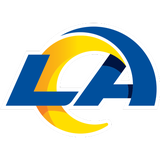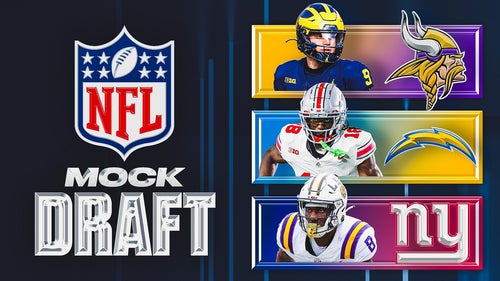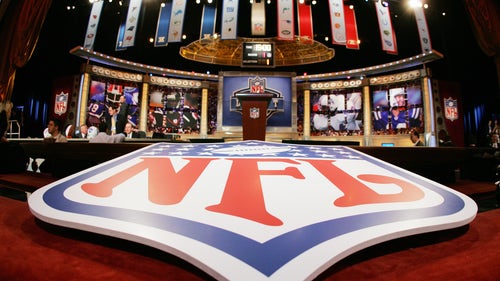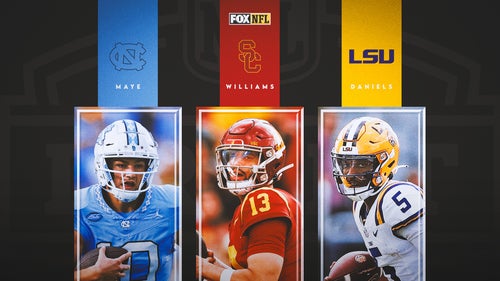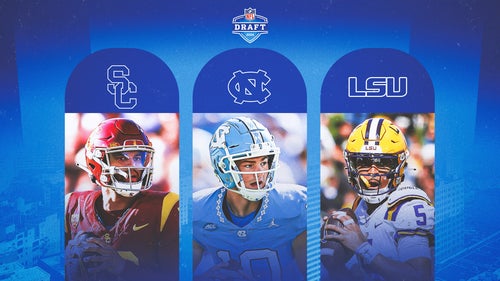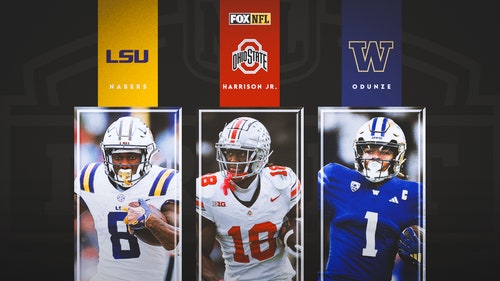
Celebrating New Orleans' 'Super' structure on its 40th birthday
Take I-10 east from Baton Rouge, La., and after about 75 miles, after you pass over Exit 232, you'll spot it: a glimpse of the New Orleans skyline with a massive, bulbous stadium in the forefront, the first thing you see as you reach the top of the hill.
That UFO-like structure is the Mercedes-Benz Superdome, and is how you know you've arrived in the Crescent City.
As it happens, the Superdome is also the oldest domed stadium in the NFL, but as the home of the New Orleans Saints since 1975 celebrates its birthday Monday, it's fair to say that 40 never looked so good.
"It's a huge part of our city, a trademark of our city, and I think most people here are very passionate here about the Superdome," 1970s Saints quarterback Archie Manning told FOX Sports last week. "They loved it when it first came in 1975, they've enjoyed it through the years, and now after Katrina, they appreciate it even more."
In the franchise's early days, the Saints made their home at Tulane Stadium, about two miles, as the crow flies, from where the Superdome stands. But the plan was never to play for long amid the sticky Bayou air, with fans dodging rainstorms and drinking cold beer from vendor backpacks filled with Jax, Dixie and Falstaff while the team struggled to find its footing in the NFL.
In fact, the Superdome was always a part of the deal to bring the league to Louisiana, and a week after Pete Rozelle and the league awarded New Orleans the Saints in November 1966, legislation was passed to build the stadium.
Modern marvels aren't built overnight, however, so it took five years for workers to break ground, on Aug. 12, 1971, and almost four years to the day after that, on Aug. 3, 1975, the Superdome opened for business, hosting a preseason game between the Saints and the Houston Oilers.
"It was a Saturday night game and we went in the night before and had kind of a walkthrough, and that was pretty exciting for all of us, to go in there, work out, and everybody's looking around," recalled Manning, who spent 11 seasons with the team from 1971-82. "It was massive and kind of breathtaking, really.
"You've got to remember, in 1975, there weren't many players who had played in a dome, unless you'd been to Houston," added Manning, who had previously visited the Astrodome as a player both in college and the pros before his Superdome debut. "So it was a lot of excitement, a lot of anticipation for this big, beautiful dome right in downtown New Orleans. It really was something."
A crowd of 72,434 packed the $163.5 million dome for that first game, which the Saints lost 13-7, but the event was not so much about winning or losing but the fact that the game was played at all. Even the stars wanted to be a part of history.

In the 1970s, Archie Manning was the New Orleans Saints.
"I wanted to win the toss because I wanted to complete the first pass in there, and we lost the toss," Manning said. "But somehow, Houston went three-up, three-down and they didn't complete a pass -- I don't think they threw one, we may have gotten a sack -- and I went in and threw a quick screen on first down just so I could say I completed the first pass."
Afterward, the locker room was abuzz with reporters asking about what the dome was like, and at times, their questions elicited memorable answers from the players.
"We had a guy, Bivian Lee, and he was from Prairie View," Manning recalled. "We lost Bivian years ago, but he called himself 'B-Lee from P.V.' and was a great guy, a cornerback and punt returner.
"Anyway, after the game, they're asking him about (the stadium), because I think he had a little trouble with a punt, and they ask him about the lights, and he said, 'Yeah, it was kind of an adjustment. Fielding punts and looking up at those lights could be a little problem, and I need to get used to it,' " Manning continued. "And then he said, 'Of course, when the season starts, it won't be a problem because we play at noon.'
"Boy, the other defensive backs saw that interview and they just wore him out. They had a good little fraternity and gave each other a hard time, but he was a good sport about it."
As was the case for most of the previous and subsequent decades, the debut season in the Superdome was a struggle for the Saints, still relative newcomers to the NFL. New Orleans went 2-12 that year, but at least both wins came at home, the first regular-season victory at the Superdome coming in a 20-19 victory on Rich Szaro's field goal on the game's final play.
From there, the Superdome would not only become a New Orleans landmark but one of the most sought-after stadiums in sports. A few months after the Saints moved in, the Superdome hosted its first Sugar Bowl, a 13-6 Alabama victory over Penn State that saw Bear Bryant shock the crowd and the world by coaching without his trademark houndstooth fedora.
"When I was a little fellow, we lived out in Moro Bottoms, Ark.," said Bryant, whose Tide beat Penn State in the Superdome once again four years later with one of the most memorable goal-line stands of all time. "We were poor dirt farmers, but my parents were proud. Mama told me never to wear my hat inside a building. I've never forgotten that."
At the end of the 1975 season, the NFL held its Pro Bowl at the Superdome. Two years later the Dallas Cowboys won the franchise's second championship, beating the Denver Broncos 27-10 under the roof in Super Bowl XII. The Superdome has hosted the Super Bowl six more times since, giving New Orleans 10 overall, tying it with Miami for the most as a host city.

Sugar Ray Leonard rejoices after defeating Roberto Duran in the Superdome.
Outside of football, the Superdome has welcomed Muhammad Ali, who earned his last professional win there, and Sugar Ray Leonard, who defeated Roberto Duran in what is now known as the "No Mas" fight in another memorable Superdome event.
There have been five Final Fours played in the dome, most recently in 2012, and the New Orleans Jazz called it their home arena for four of their first five years in existence, before moving to Salt Lake City in 1979. The Superdome has doubled as a baseball stadium and was at times linked to potential relocations by the Oakland Athletics and the Pittsburgh Pirates, though neither move panned out.
Away from sports, the Superdome has hosted concerts by some of the most recognizable artists in music -- the Rolling Stones set a then-record for indoor concert attendance by playing in front of 87,500 in 1981 -- as well as a Papal visit in 1987, the Republican National Convention in 1988 and WrestleMania last year.
But mostly, the Superdome is synonymous with the Saints, and any former Saint will be glad to tell you how much it means to call the building home.
"It was state of the art," said Morten Andersen, the team’s kicker from 1982-94. "I just remember it looked like a giant spaceship, and the energy in the building was incredible. The fans, and the noise -- it was almost surreal being in there because it was so big. And you just felt really small being in there, yet it was intimate, with the fans. You felt small because of the size of the building was just enormous."
A Hall of Fame finalist each of the last two years, Andersen was a legend during his 13 years he spent with the Saints. The team’s all-time team leader in games played with 196, Andersen also holds franchise records for points, field goals and extra points, but he says the charm of playing in New Orleans is about more than just a stadium. It's about the people the people who work there and the fans who show up to the games each weekend.
The Superdome, he says, happens to be the perfect building to house them all.
"I would always get to the stadium early, three hours before kickoff, and you say hi to the same people, the parking lot attendants, and it was kind of a ritual, giving people hugs along the way," said Andersen, who played his last NFL game in 2007, at age 47. "It was the same security, same people, same sideline guys, same ball guys. All of those things created a special family atmosphere in the Superdome, and I really felt that people loved working there.
"So it was just wonderful on game days to come in, and around the dome it was lively, too, with all the bars and restaurants," Andersen continued. "Leading up to a game, it started on Friday, Saturday. It was like church for people, going to a Saints game in the Superdome. It was church. There was God, family, the Saints and the Superdome. It's part of the fabric of New Orleans."

Willie Roaf experienced the Superdome before he was a Saint, and he was in awe.
Hall of Famer Willie Roaf played offensive tackle for New Orleans from 1993-2001, but Roaf says he wasn't a Saint when he got his first taste of that Superdome experience. That came in 1992, two weeks after his final game with Louisiana Tech.
"I had never been to a pro football game, and I remember when I was a kid, my daddy used to take me to War Memorial Stadium in Little Rock -- I grew up in Pine Bluff -- to see the Razorbacks play against various teams," Roaf said. "So when I came out of college, a lot of agents were coming after me, and Wayne Martin's agent, I remember, they picked me up in Pine Bluff, this was around Christmas time, on a private jet and took me on that jet to New Orleans.
"We walked into the Superdome and I just heard the roar of the crowd. We sat down during the game -- it was Bob Whitfield's first start for the Falcons, and I remember seeing Deion (Sanders) and walking in there and thinking 'Yeah, this is the NFL.' "
Less than five months later, the Saints took Roaf with the eighth overall pick in the NFL Draft, a selection acquired when the team dealt linebacker Pat Swilling to Detroit, effectively breaking up the famed Dome Patrol defense. Over the next nine seasons, Roaf emerged as one of the top offensive linemen in the game, eventually helping to lead the franchise to its first playoff win, a 31-28 Wild-Card victory over the Rams in 2000 -- a win that came in the Superdome, of course.
"When you walk out into the dome, I just remember, the roar of the crowd," Roaf said. "It meant it was almost time for the game to get started, and, whoo, when it's loud in a full stadium, it's deafening. Your ears are going to be ringing. ... With the music they play every time they score and the crowd, all the stuff they do during the game with the fans, it's an experience. The whole game is a production, and it's special to be in that atmosphere, especially for a big game. It's a lot of excitement."
As the Saints were beginning to turn a corner as a franchise, disaster struck New Orleans when Hurricane Katrina destroyed the area in August 2005, understandably putting everything but survival on the back burner. And the Superdome, once the site of some of the most joyous moments in the city's history, became an emergency shelter for more than 20,000 New Orleanians seeking refuge from the storm.
The days after the hurricane were some of the lowest in the city's and the Superdome's history. In addition to the damage to the building's roof, the dome deteriorated to what the New York Times described as "a sweltering and surreal vault, a place of overflowing toilets and no showers," as hunger, crime and sickness overwhelmed the growing crowds inside.

Morten Andersen got plenty of kicks from being a Saint in the Superdome.
The scene had become so seemingly irreparable inside that there were reports of the Superdome being demolished. Instead, leaders put more than $336 million into the renovation of the facility, with the majority of the funds coming from FEMA and the state of Louisiana, making it a point to restore the city's most iconic building.
"Certainly Katrina was a hiccup for us, and many of us weren't sure if we could put this building back together," said Louisiana native and SMG vice president Doug Thornton while accepting the Saints' Joe Gemelli Fleur de Lis award earlier this year. "It was a trying time, but it has served as a symbol of our recovery, and here we are on the verge of the 10th anniversary better than ever. The facility has withstood the test of time, and there are still great things to come."
"He was one of the great leaders in our city, post-Katrina, and got the dome back up and going so the Saints could come back," Manning added of Thornton, who oversaw the renovation of the Superdome. "If he hadn't done that, if it hadn't happened and they couldn't come back, the Saints might not be here."
As workers restored the Superdome, the Saints played their 2005 home slate among Tiger Stadium in Baton Rouge, the Alamodome in San Antonio and Giants Stadium in East Rutherford, N.J., but on Sept. 25, 2006, just over a year after the storm, the Superdome reopened with the Saints hosting the Falcons on “Monday Night Football.”
Manning was in attendance, hosting a countdown to the reopening of the doors and watching the game from the field, as was Andersen, then a kicker with Atlanta. It was an experience Andersen says he'll never forget.
"It was pretty evident before the game that we, being the Falcons, were not going to win that game," Andersen said. "There was so much energy in the city and for the Saints, and it was just destiny that they were going to win. There was no chance for us to come in there and spoil that. They were up for it, the fans were up for it, and it was electric."
Once the game kicked off, it took just 90 seconds for the Superdome to truly become the Superdome again, as Curtis Deloatch recovered Steve Gleason's blocked punt in the end zone for the first touchdown of the post-Katrina era in New Orleans.
"I don't know how to explain it, other than to say that if the roof hadn't been well-fastened, it would have blown off," Andersen said of the play. "The noise was incredible, the energy was incredible, and I was glad to be a part of it. Although I was playing for a team in a different uniform, I was glad to be there. It was a historic moment in sports and for the city and for the dome and for its fans and for the people of New Orleans."
"It was very emotional for a lot of people," Manning added. "I remember Jimmy Mora Jr. (son of longtime Saints coach Jim Mora) was the coach of the Atlanta Falcons, and I called Jimmy the next day and said, 'You never had a chance, did you?' and he said, 'Not a chance. We should have stayed home.' It was just too much emotion in there."
The Saints would go on to win that game 23-3, but the victory, ultimately, was secondary to what the night meant for the city.
"The place was a gathering point again," Andersen said. "It was sort of, 'Let's get on with things.' As horrible as Katrina was and as horrible as the conditions in the dome were during that time, and as horrible as the city was treated in the aftermath, the dome very much became a catalyst of new hope and a new beginning, and I think it was pretty much cemented with that win against the Falcons that Monday night.
"The city needed it, the people needed it, and it was well-deserved and overdue," he continued. "We just happened to be in the way that particular night, but it was an important statement, I think, that the dome was rebuilt and was open for business again. It was a very important milestone for everybody."
In February 2010, the Saints won the franchise's first Super Bowl, clinching the NFC championship on the way with a 31-17 win over Peyton Manning and the Colts at home. Since the Saints returned to the Superdome in 2006, the team has won 93 games, including six in the playoffs; in the previous 39 seasons, New Orleans won 238, only one coming in the postseason.
It's impossible to say whether the Saints could have or would have done it without the Superdome to call home, but fortunately for the team and the people of New Orleans, no one ever had to find out. And now, as the Superdome begins its fifth decade in operation, things are better than ever.
"For more than 40 years, those peoples have lived and breathed the Saints," Roaf said. "I still go down there and people talk about how they used to go to Tulane Stadium and they've been season ticket holders their whole life.
"The Saints and the Superdome are part of the legacy of New Orleans," Roaf continued. "Since the Saints came along, New Orleans and football and the Superdome have been a part of the history of the city. If you look at New Orleans, the timeline of some of the things that have happened, people know what was going on by what the Saints were doing, and a lot of these people's lives are attached to what was going on at the dome and that football team."
You can follow Sam Gardner on Twitter or email him at samgardnerfox@gmail.com.
